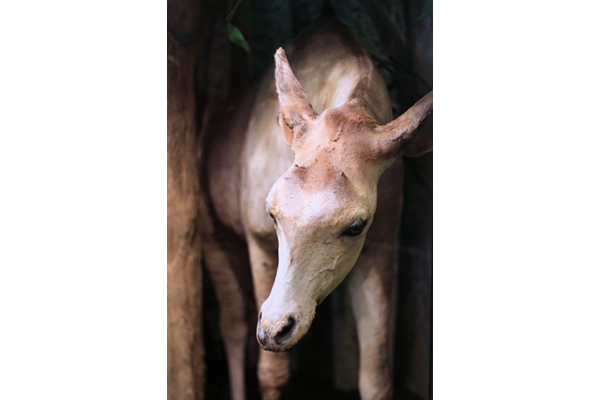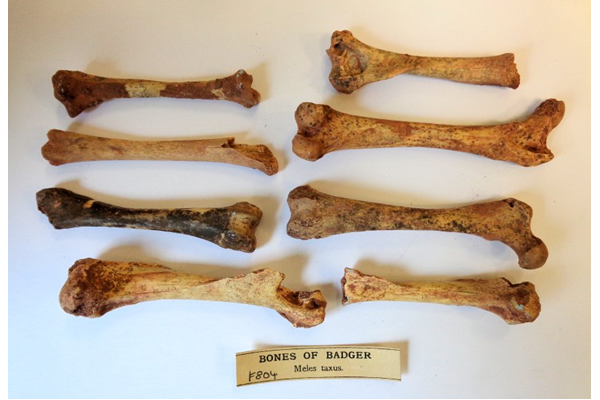Natural Sciences
The McLean's natural history collection is substantial and reflects the considerable importance attached to collecting in this field over the years of the Museum's existence from its inception up until the 1940s. The holding of bird specimens, mainly mounted for display, numbers over 950 and includes significant species such as the extinct Passenger Pigeon and Eskimo Curlew. Other animal groups are represented, including several thousand specimens of insects (mainly Coleoptera and Lepidoptera), and molluscs. The origin of the animal material is world-wide and includes the large mounted big game specimens of R.L. Scott of Scott’s Shipbuilders, Greenock. A number of his specimens are on permanent display and include a Nile crocodile and an Indian Tiger. An Okapi and a Bongo are also on show, both rare animals in museum collections. There are over 1100 herbarium specimens mainly local to Inverclyde.
There are 950 specimens in the fossil collection which includes examples from the animal and plant groups. The specimens mainly come from Scotland, England and Ireland with a few European specimens. There are 637 specimens in the mineral collection. It is a general collection containing a wide range of specimens from around the world and from across the major mineral groups including native elements, carbonates, oxides, sulphides, sulphates and phosphates. Of particular note are the specimens from Canada and Australia.
This are over 3,100 specimens of insects. These comprise 1,587 butterflies, 558 moths and 1,008 coleoptera specimens. Although the collection has large numbers of British specimens there are also holdings of butterflies, moths and beetles from around the world. The specimens date from the mid nineteenth century to the mid twentieth century. Most of the specimens are dried and pinned. The most significant group within the collection are the 67 specimens of mimicry butterflies and moths donated by George Rodgers Macdougall (1843-1917).

Beryx lewesiensis
Beryx lewesiensis. Fossil fish Beryx lewesiensis in chalk rectangular paper label affixed to top with 'Mr Gideon Mantell's Coll' written in ink and 'Mus M & M' printed below. This specimen was previously part of the collection of Gideon Algernon Mantell (1790-1852). - F360 - © McLean Museum and Art Gallery, Greenock

Beryx lewesiensis
Fossil fish Beryx lewesiensis in chalk with rectangular paper label affixed to top with 'Mr Gideon Mantell's Coll' written in ink and 'Mus M & M' printed below. Printed label states species is Beryx lewesiensis from Kent, Upper Cretaceous, Upper Chalk. This specimen was previously part of the collection of Gideon Algernon Mantell (1790-1852). - F361 - © McLean Museum and Art Gallery, Greenock

Beryx superbus
Fossil fish in chalk. Paper label affixed to top left with 'Mr Gideon Mantell's Coll' written in ink and 'Mus M & M' printed below. This specimen was previously part of the collection of Gideon Algernon Mantell (1790-1852). - F362 - © McLean Museum and Art Gallery, Greenock

Sloth Bear
Melursus ursinus (Sloth Bear) from Isli, Central Provinces, India. This specimen was shot by local shipyard owner Robert Lyons Scott (1871-1939) in 1928. - 2001.230 - © McLean Museum and Art Gallery, Greenock

Alligator Gar
Atractosteus spatula (Alligator Gar). This specimen caught on rod and line 21 April 1935 at Panuco River, Tampico, Mexico by Robert Lyons Scott (1871-1939). - 2001.231 - © McLean Museum and Art Gallery, Greenock

Indian Tiger
Panthera tigris tigris (Indian Tiger). This specimen was shot on 7.2.1928 at Supkar, Central Provinces, India by Robert Lyons Scott (1871-1928). - 2001.232 - © McLean Museum and Art Gallery, Greenock

Nile Crocodile
Crocodylus niloticus (Nile Crocodile). This specimen was shot on the 31.01.1920 at Shambe, White Nile, Sudan by Robert Lyons Scott (1871-1939). - 2001.233 - © McLean Museum and Art Gallery, Greenock

Bongo
Tragelaphus eurycerus (Bongo). This specimen was shot by Sir William Northrup McMIllan (1872-1925). - 2001.234 - © McLean Museum and Art Gallery, Greenock

Okapi
Okapia johnstonii (Okapi). This specimen was shot by Sir William Northrup McMillan (1872-1925). - 2001.235 - © McLean Museum and Art Gallery, Greenock

Mounted Insect and Other Specimens
Late nineteenth / early twentieth century wooden hinged case containing specimens of beetles, butterflies, scorpions, moths and other insects mounted using tape and pins. - 2008.1 - © McLean Museum and Art Gallery, Greenock

Kingfisher
Mounted male specimen of Megaceryle maxima (Giant Kingfisher) shot at the Thika River, Kenya on 16 November 1911 by Robert Lyons Scott (1871-1939). - A331 - © McLean Museum and Art Gallery, Greenock

Egyptian Vulture
Mounted specimen of immature male Neophron percnopterus (Egyptian Vulture) formerly known as Aegyptius occipitalis (Abyssinian Vulture or White Headed Vulture) shot at Kafue River, Zambia on the 24 September 1914 by Robert Lyons Scott (1871-1939). - A401 - © McLean Museum and Art Gallery, Greenock

Ground Hornbill
Mounted specimen of Bucorvus abyssinicus (Northern Ground Hornbill), formerly known as the Abyssinian Ground Hornbill, shot at Yatta Plains, Kenya on 23 November 1911 by Robert Lyons Scott ( 1871-1939). - A409 - © McLean Museum and Art Gallery, Greenock

Guinea Fowl
Mounted specimen of Numida meleagris (Helmeted Guineafowl) shot at Mukuyu, Kenya in 1911 by Robert Lyons Scott ( 1871-1939). - A464 - © McLean Museum and Art Gallery, Greenock

Papilio polymnestor
Papilio polymnestor (butterfly) - BU230 - © McLean Museum and Art Gallery, Greenock

Heliconius doris
Heliconius doris (butterfly) - BU242 - © McLean Museum and Art Gallery, Greenock

Baeotus baeotus
Baeotus baeotus (butterfly) - BU248 - © McLean Museum and Art Gallery, Greenock

Ptychodus decurrens
Ptychodus decurrens. Fossil fish tooth from Kent, England. Ptychodus was a genus of durophagous (shell-crushing) sharks from the Late Cretaceous. - F268 - © McLean Museum and Art Gallery, Greenock

Otodus obliquus
Otodus obliquus. Fossil fish tooth from Otodus obliquus discovered on the 25.4.1893 at 3.15 p.m. London Clay, Eocene system, Cliffs, north of Walton-on-Naze, Essex. - F275 - © McLean Museum and Art Gallery, Greenock

Badger Bones
Bones of Meles taxus (Badger), originally excavated by William Pengelly (1812-1894) as part of his investigation of Happaway Cave at Torquay, Devon. - F804 - © McLean Museum and Art Gallery, Greenock

Fossil Stigmaria
This specimen of fossil stigmaria was dug out of one of the last practice trenches made by The 1/5 Argyle and Sutherland Highlanders, dug a few days before sailing for the Dardanelles in 1915. - F936 - © McLean Museum and Art Gallery, Greenock




















